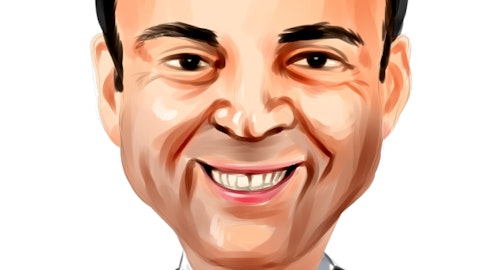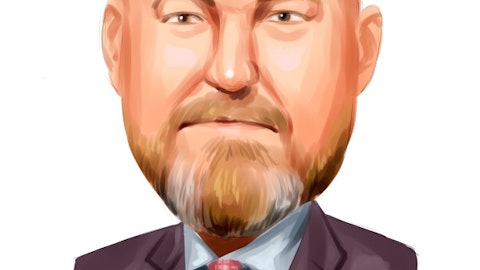
In addition to being the CEO and founder of ESL Investments, Lampert is also the chairman of Sears Holdings Corporation. Lampert is a Yale undergrad alum and ex-Goldman Sachs analyst. He started ESL in 1988 with a modest $28 million, and now ranks on Forbes’ list of richest people with an estimated net worth over $3 billion.
ESL’s top investment according its 2Q 13F was Sears Holding Corporation (NASDAQ:SHLD). Sears is the broadline retailer that operates Sears and K-Mart stores. Sears is ESL’s overwhelming top pick, with the firm having over almost 45% of its 2Q 13F portfolio invested in the company. Sears is up over 90% year to date, but was flat for the third quarter.
Sears is projected to post net sales down 5.6% in 2013 as competition continues to put pressure on the company. The company has faced a slowdown in same-store sales as the likes of Amazon imposes on the retail market. As well, other retailers, such as Target and Best Buy, are getting more competitive with price matching. We would be concerned for ESL’s fund performance next year given its concentration in Sears. Sears is expected to is EPS down over 50% next year as a continued lag in the housing market puts a damper on its legacy appliance business. However, Sears is a Bruce Berkowitz top pick.
Rounding out ESL’s top five picks according to its 2Q 13F are AutoNation, Inc. (NYSE:AN), The Gap Inc. (NYSE:GPS), AutoZone Inc. (NYSE:AZO), and Capital One Financial Corp (NYSE:COF). ESL has a concentrated portfolio with over 95% of the firm’s 13F invested in these five holdings. AutoNation has helped keep ESL’s 3Q performance positive, being up almost 20% during 3Q. ESL has nearly 30% of its 13F invested in the company. AutoNation saw positive 3Q performance thanks to a boost in light vehicle sales, up 28%, and a rebound in Japanese sales following the natural disasters. The outlook for AutoNation is positive, with expected sales to be up 13% in 2013 as new vehicle sales benefit as aging vehicles are replacement. While ESL owns the most shares of any fund by far, at 48 million, we were not encouraged by the vast downsizing by other top fund managers. D.E. Shaw dumped 11% of his 1Q stake in 2Q, while AQR Capital and Ken Griffin dumped around 50% each.
The Gap also helped boost ESL’s performance in 3Q. The fund had almost 14% of its 13F invested in the clothing retailer, which was up over 30% in 3Q after two consecutive quarters of positive comps. Same store sales were up 4% for the first half of the year, compared to a 2% decline for the same period last year. The company has also repositioned Old Navy to regain market share in the value sector, but may see a slowdown in the segment’s turnaround as high unemployment pressures the value-oriented customers. The second largest fund by shares, behind ESL, was Lone Pine Capital, having upped its stake by 90% during 2Q.
AutoZone also saw Lone Pine Capital as a top investor, this time leading ESL in shares. ESL’s investment in AutoZone was a new position for the company during 2Q, check out other funds bullish on the auto industry. AutoZone saw EPS for 2Q up to $8.46, versus $7.18 from the same quarter last year, and same store sales up 2.1%. The auto parts company is being driven by the increasing number of vehicles that are still in operation that are seven years or older. However, AutoZone was flat for the third quarter and still trades in line with industry peers with a P/E of 16x, compared to as Advance Auto’s 13x and Pep Boys’ 15x.
ESL’s final top five pick is Capital One. The company is up almost 10% for 3Q and expects to look for growth going forward by seeking out spenders rather than borrowers. Earlier this year Capital One acquired ING Direct, which raised it deposits by 75%. Following this acquisition, Capital One acquired HSBC’s $27.6 billion U.S. card portfolio. Capital One’s recent earnings announcement was the first to include both HSBC and ING, allowing the company to beat earnings estimates by 20%. We have not been encouraged by the insider of sales of late, nor the selloff by John Paulson during 2Q. Yet, in a recent interview, billionaire Julian Robertson named Capital One as a good investment opportunity.





